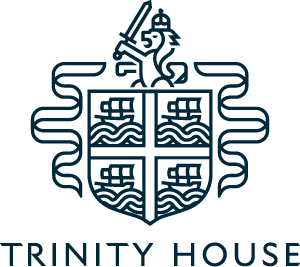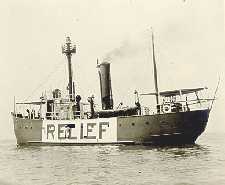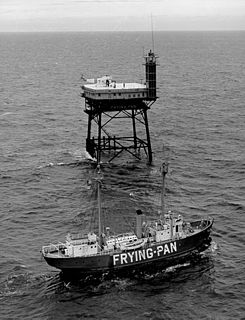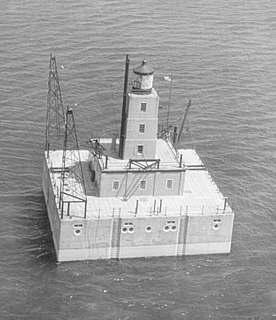
The Corporation of Trinity House of Deptford Strond, also known as Trinity House, is the official authority for lighthouses in England, Wales, the Channel Islands and Gibraltar. Trinity House is also responsible for the provision and maintenance of other navigational aids, such as lightvessels, buoys, and maritime radio/satellite communication systems. It is also an official deep sea pilotage authority, providing expert navigators for ships trading in Northern European waters.

A lightvessel, or lightship, is a ship that acts as a lighthouse. They are used in waters that are too deep or otherwise unsuitable for lighthouse construction. Although some records exist of fire beacons being placed on ships in Roman times, the first modern lightvessel was off the Nore sandbank at the mouth of the River Thames in England, placed there by its inventor Robert Hamblin in 1734. The type has become largely obsolete; lighthouses replaced some stations as the construction techniques for lighthouses advanced, while large, automated buoys replaced others.
The history of lightvessels in the United Kingdom goes back over 250 years. This page also gives a list of lightvessel stations within the United Kingdom, the Channel Islands and Gibraltar.

The United States Lighthouse Service, also known as the Bureau of Lighthouses, was the agency of the United States Government and the general lighthouse authority for the United States from the time of its creation in 1910 as the successor of the United States Lighthouse Board until 1939 when it was merged into the United States Coast Guard. It was responsible for the upkeep and maintenance of all lighthouses and lightvessels in the United States.

The Nore is a long bank of sand and silt running along the south-centre of the final narrowing of the Thames Estuary, England. Its south-west is the very narrow Nore Sand. Just short of the Nore's easternmost point where it fades into the channels it has a notable point once marked by a lightship on the line where the estuary of the Thames nominally becomes the North Sea. A lit buoy today stands on this often map-marked divisor: between Havengore Creek in east Essex and Warden Point on the Isle of Sheppey in Kent.

Greenwich Light Vessel Automatic is a lightvessel station in the English Channel, off the coast of East Sussex. It is operated by Trinity House. It is one of the 22 coastal weather stations whose conditions are reported in the BBC Shipping Forecast but was dropped from broadcasts some time during 2019, before being reinstated. The name of the station derives from the fact that is located close to the Greenwich Meridian.

The Lightship Finngrundet is a lightvessel built in 1903 and now a museum ship moored in Stockholm, Sweden.

The United States lightship Huron (LV-103) is a lightvessel that was launched in 1920. She is now a museum ship moored in Pine Grove Park, Port Huron, St. Clair County, Michigan.

Sevenstones Lightship is a lightship moored off the Seven Stones Reef which is nearly 15 miles (24 km) to the west-north-west (WNW) of Land's End, Cornwall, and 7 miles (11 km) east-north-east (ENE) of the Isles of Scilly. The reef has been a navigational hazard to shipping for centuries with seventy-one named wrecks and an estimated two hundred shipwrecks overall, the most infamous being the oil tanker Torrey Canyon on 18 March 1967. The rocks are only exposed at half tide. Since it was not feasible to build a lighthouse, a lightvessel was provided by Trinity House. The first was moored near the reef on 20 August 1841 and exhibited its first light on 1 September 1841. She is permanently anchored in 40 fathoms (73 m) and is 2.5 miles (4.0 km) north-east (NE) of the reef. Since 1987, the Sevenstones Lightship has been automated and unmanned.

Channel Light Vessel Automatic is the name of a lightvessel in the English Channel. It is one of the 22 coastal weather stations whose conditions are automatically reported in the BBC Shipping Forecast. The vessel's position is 49°55′N2°54′W, approximately 56 km (35 mi) north-northwest of Guernsey.
The Seven Stones reef is a rocky reef nearly 15 miles (24 km) west-northwest (WNW) of Land's End, Cornwall and 7 miles (11 km) east-northeast (ENE) of the Isles of Scilly. The reef consists of two groups of rocks and is nearly 2 miles (3.2 km) long and 1 mile (1.6 km) in breadth. They rise out of deep water and are a navigational hazard for shipping with 71 named wrecks and an estimated 200 shipwrecks overall. The most infamous is the Torrey Canyon in 1967, which was at that time the world's costliest shipping disaster, and to date, still the worst oil spill on the coast of the United Kingdom.

Frying Pan (LV-115) is a lightvessel moored at Pier 66a in the Chelsea neighborhood of Manhattan in New York City. It served at Frying Pan Shoals, off Cape Fear in North Carolina, for over 30 years.

Lightship 2000 was a restored old red lightvessel with a cafe and chapel on board situated in Cardiff Bay. During the redevelopment of Cardiff Bay, the Cardiff Bay Development Corporation called together the churches in Cardiff to discuss the role of Christianity in the Bay. Lightship 2000 was the result of these discussions.

The Lansing Shoals Light Station is a lighthouse located in northeastern Lake Michigan, 6.3 miles (10.1 km) southeast of Point Patterson, in Newton Township, Mackinac County, Michigan. It was listed on the National Register of Historic Places in 2005.

Philip and Son was a shipbuilder in Kingswear, near Dartmouth, Devon, England. Operating from 1858 until the late 1990s, the company provided employment opportunities for nearly 141 years for many people of Dartmouth. It was Dartmouth's last industrial shipyard. A documentary film, Philip and Son, A Living Memory, presents the story of the industrial shipyard from its beginning to its eventual closure.

The Lightship Museum in the harbour of Esbjerg in southern Denmark consists of a private museum open to the public on board the Horns Rev lightship. Dating from 1912, the Horns Rev, also known as Motorfyrskibet Nr. I, is the world's oldest and best preserved motor lightship. It houses a highly regarded exhibition of life and work on board.
The Kentish Knock is a long shoal in the North Sea east of Essex, England. It is the most easterly of those of the Thames Estuary and its core, which is shallower than 18 feet (5.5 m), extends 6 miles (9.7 km). Thus it is a major hazard to deep-draught navigation. It is exactly 28 miles (45 km) due east of Foulness Point, Essex and is centred about 15 miles (24 km) NNE of North Foreland, Kent – both are extreme points of those counties.
Five Fathom Bank light station was a station for lightvessels in New Jersey, United States. It was located off the south end of Five Fathom Bank, 14.7 miles and 100 degrees from the Cape May Lighthouse. The station was in service from 1837 to 1972 before ultimately being replaced by a horn buoy.

The Sandettie Bank is an elongated sandbank in the southern North Sea, more specifically about in the middle of the northeastern entrance to the Strait of Dover. North-west of it are the hazardous Goodwin Sands, south of it the sandbank Ruytingen.

The Bahama Bank Lightship was a Lightvessel stationed on the Bahama Bank east of Ramsey Bay, Isle of Man.


















